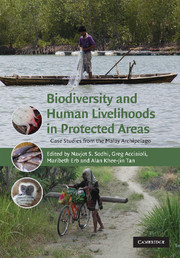Book contents
- Frontmatter
- Contents
- List of contributors
- Acknowledgements
- 1 General introduction
- Part I Conservation needs and priorities
- 2 Introduction to Part I
- 3 Delineating Key Biodiversity Areas as targets for protecting areas
- 4 A Master Plan for Wildlife in Sarawak: preparation, implementation and implications for conservation
- 5 Indonesia's protected areas need more protection: suggestions from island examples
- 6 Birds, local people and protected areas in Sulawesi, Indonesia
- 7 Importance of protected areas for butterfly conservation in a tropical urban landscape
- 8 Biodiversity conservation and indigenous peoples in Indonesia: the Krui people in southern Sumatra as a case study
- 9 Involving resource users in the regulation of access to resources for the protection of ecosystem services provided by protected areas in Indonesia
- 10 Conclusion to Part I
- Part II Conservation with and against people(s)
- Part III Legal and governance frameworks for conservation
- 29 General conclusion
- Index
- References
3 - Delineating Key Biodiversity Areas as targets for protecting areas
from Part I - Conservation needs and priorities
Published online by Cambridge University Press: 12 November 2009
- Frontmatter
- Contents
- List of contributors
- Acknowledgements
- 1 General introduction
- Part I Conservation needs and priorities
- 2 Introduction to Part I
- 3 Delineating Key Biodiversity Areas as targets for protecting areas
- 4 A Master Plan for Wildlife in Sarawak: preparation, implementation and implications for conservation
- 5 Indonesia's protected areas need more protection: suggestions from island examples
- 6 Birds, local people and protected areas in Sulawesi, Indonesia
- 7 Importance of protected areas for butterfly conservation in a tropical urban landscape
- 8 Biodiversity conservation and indigenous peoples in Indonesia: the Krui people in southern Sumatra as a case study
- 9 Involving resource users in the regulation of access to resources for the protection of ecosystem services provided by protected areas in Indonesia
- 10 Conclusion to Part I
- Part II Conservation with and against people(s)
- Part III Legal and governance frameworks for conservation
- 29 General conclusion
- Index
- References
Summary
Introduction
Biodiversity faces a crisis, with extinction rates approximately three orders of magnitude higher than those typical of the Earth's history (Pimm et al. 1995). This crisis has numerous negative consequences for humanity, including to economies, health, environmental services, and moral and spiritual well-being (Wilson 2002). The biodiversity crisis is particularly serious in Southeast Asia (Sodhi et al. 2004; Sodhi & Brook 2006), where wholesale extinctions are already in the process of unfolding (Brook et al. 2003). Among a large number of causes of these extinctions, the destruction of natural habitats is the most pervasive, affecting ~90% of all threatened species (Baillie et al. 2004). Given this, it is clear that the primary tactic necessary to stem the crisis is to safeguard sites of global biodiversity significance. This has received intergovernmental mandate, with, for example, the 188 parties to the Convention on Biological Diversity agreeing on a Programme of Work on Protected Areas (http://www.biodiv.org/programmes/cross-cutting/protected) to support the establishment and maintenance ‘of comprehensive, effectively managed, and ecologically representative national and regional systems of protected areas’ (Decision VII/28). However, this raises the question of how these sites can best be identified and delineated.
This chapter addresses this question. We begin by explaining the variety of factors that require consideration in the identification of those areas requiring site safeguard. Next, we show how the approach of identifying and delineating Key Biodiversity Areas (KBAs) emerges from these considerations. Finally, we discuss the issue of how KBAs can best be delineated.
- Type
- Chapter
- Information
- Biodiversity and Human Livelihoods in Protected AreasCase Studies from the Malay Archipelago, pp. 20 - 35Publisher: Cambridge University PressPrint publication year: 2007
References
- 1
- Cited by



